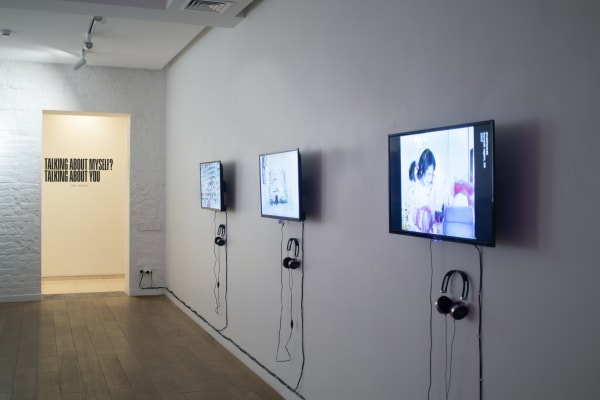Talking about Myself? Talking about You
Past exhibition
Overview
Voloshyn Gallery is delighted to announce a group exhibition Talking about Myself? Talking about You, curated by Mykola Ridnyi.
Participants: Kateryna Vishneva, Open Group, Sashko Protyah, Dasha Chechushkova, and Kamila Yanar.
In the context of war, the notion of human experience becomes identical with the notion of trauma. It is routinely said that a collective trauma is made up of personal stories. But does this really work the way it sounds? Media representation of war is able to crowd out memories of things seen with one’s own eyes. Dramatic and tragic but above all visually striking images of explosions, ruins, killed people create a canonical way of documenting war as a catastrophe. This collective catastrophe often renders personal trials invisible and indistinguishable. Our exhibition gives voice to personal experiences constituting its collective body. This body is composed of differences and similarities; its underlying principle is polyphony rather than rule of collective morality.
This exhibition presents reformatting of trauma as an artistic method. Instead of documenting the war, the artists included in the display use performative actions to reflect upon their own experiences or experiences of their friends and acquaintances. These actions are not a journalist commentary attached to reality; they are at the same time a part of this reality, a way to endure it, and an alternative historical document for the future. The coordinate system within which war is experienced comprises time and space. War divides territories and relationships. This particular war has also divided our time into before and after February 24. It deferred the future (in the sense of planning) and erased the past (in the sense of values and priorities). Does this situation leave room for personal feelings? Can they be heard if they fail to resonate with collective experience? Reformatting of trauma often means reliving it, repeating the experience, which may hurt the artist and trigger the viewer. But is this not the way to overcome pain that people hold within and fruitlessly try to suppress?
The video by Kamila Yanar comments on contemporality by speaking to us from the past. The artist, born and raised in a Tatar family, used to live in Shakhtarsk, a town that has been controlled by the self-proclaimed pro-Russian “Donetsk People’s Republic” since 2014. The video is composed of recordings that show the artist mocking entertainment TV shows from her childhood. Contrary to the popular opinion on the region, those were Ukrainian shows featuring Ukrainian characters but not Russian. The work examines the complexity of the notion of national identity, which is simplified and manipulated by propagandists.
In the first days of the full-scale invasion in 2022, Kateryna Vishneva decided to stay in Kyiv despite the risk of its capture by the Russian army. After Russian missiles hit several apartment buildings and the TV tower near Babyn Yar, she started coming to the place and reciting on-camera poems by the Ukrainian dissident poet Mykola Kholodnyi, strangely sounding like a commentary on the current events.
Dasha Chechushkova created her work while at an artist residency in Italy. It explores the topic of experiencing war from afar, staying in other country. Instead of juxtaposing scenery of a sunny island of Sardinia with a war-torn Ukrainian landscape, the artist takes the opposite approach, producing a claustrophobic feeling. In the closed space of an abandoned tobacco factory, she draws landscapes and people who inhabit her dreams and memories, erases the images and draws again time after time. The drawings are then turned into an animated gloomy tale (or anxiety-ridden essay) telling a story about the ways in which the sociopolitical affects the personal.
Having spent the beginning of the war in Mariupol, Sashko Protyah later moved to Zaporizhzhia. His film tells about people with whom he is connected by a shared experience, namely about a group of volunteers who evacuated civilians from Mariupol in spring 2022, when the city was already encircled by the Russian forces. After the evacuation trips, they meet to talk, support each other and discuss their traumatic experiences. The film uses footage from the volunteers’ phones, videos from the artist’s personal archive, as well as 3D animated scenes depicting dangerous or shocking situations that were impossible or prohibited to film.
The work by the Open Group stands out in this exhibition as the only piece where performing is delegated to the social group it is devoted to. In the video, people from the east of Ukraine who fled the hostilities and found shelter in Lviv share their experiences, familiar to everyone whose city or village was affected by war. Very few actual words can be heard; instead, we see people imitating sounds, particularly those of assault rifle bursts, artillery shell explosions and air defense systems firing. This work is styled as a sort of karaoke: the audience is encouraged to make sounds along with the people in the video. This makes the viewer participate in the performance, which, in turn, becomes a commentary on the unity of the personal and the collective, on individual experience being inevitably echoed by experiences of others.
02.06.2023 – 09.07.2023
Opening reception: Friday, June 2, 6-8 pm
Voloshyn Gallery, Kyiv, 13 Tereschenkivska st.
Installation Views
Press release





